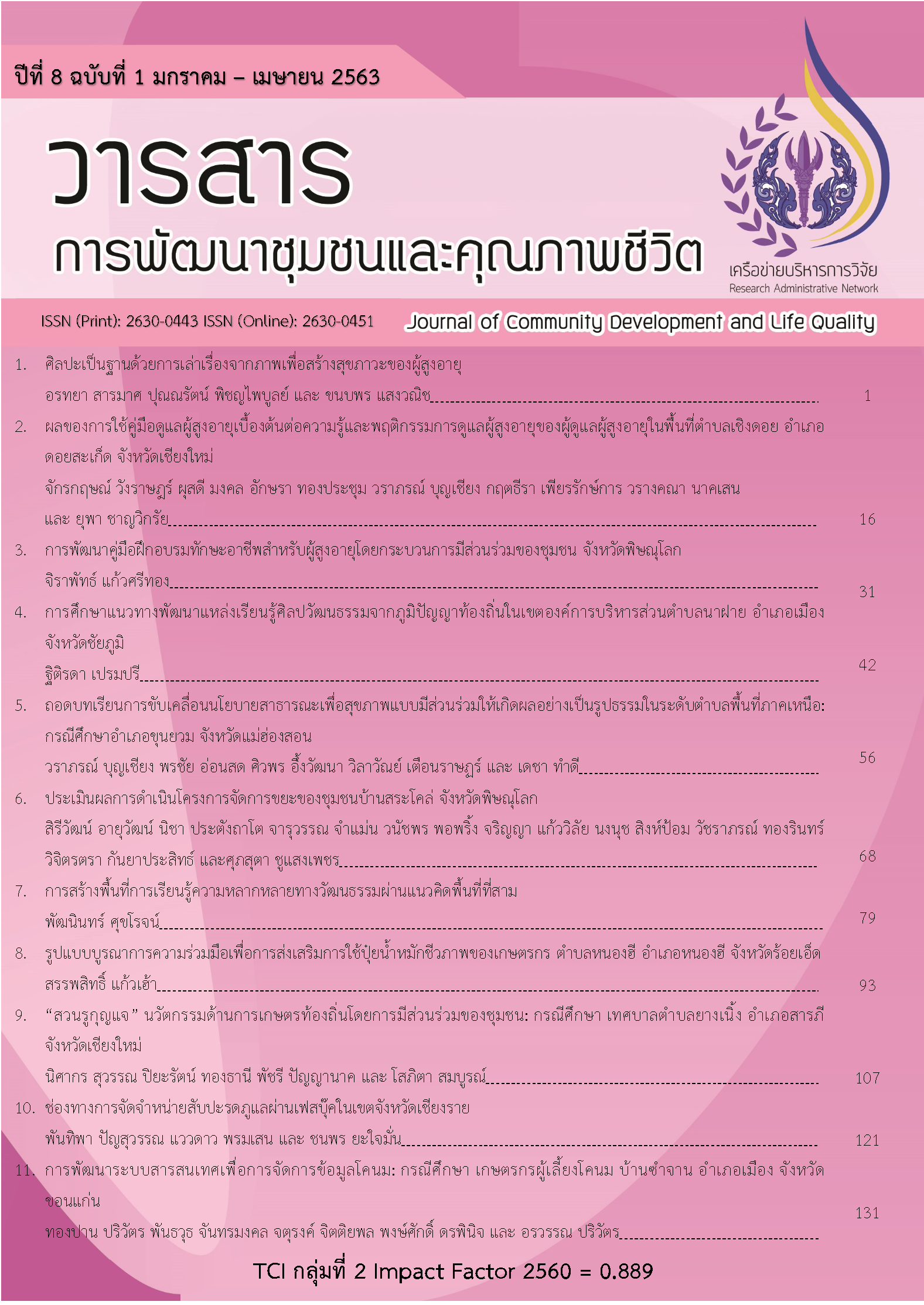สารประกอบฟีนอลิกและการยับยั้งเชื้อแบคทีเรียก่อโรคของน้ําหมักสาบเสือและประยุกต์ผลิตเป็นน้ํายาทําความสะอาดพื้นผิวในหมู่บ้านท่องเที่ยวและศูนย์การเรียนรู้ชุมชนสายยาว ต. ถลุงเหล็ก จ. บุรีรัมย์
Main Article Content
บทคัดย่อ
ผลิตน้ำหมักจากสาบเสือโดยใช้เอทานอลร้อยละ 95 เป็นตัวทำละลายโดยใช้เวลาในการสกัด 30 วัน ทดสอบการยับยั้งแบคทีเรียก่อโรคและวิเคราะห์สารประกอบฟีนอลิกและสารต้านอนุมูลอิสระเปรียบเทียบกับน้ำหมักสมุนไพรพื้นบ้านที่ผลิตโดยชุมชนสายยาว (ผสมระหว่างมะกรูด มะนาว และมะเฟือง) พบว่าน้ำหมักสาบเสือสามารถยับยั้งเชื้อแบคทีเรีย Bacillus cereus (ATCC 035) และ Bacillus subtilis (ATCC 001) ได้ดีกว่าน้ำหมักสมุนไพรพื้นบ้าน นำน้ำหมักสมุนไพรทั้ง 2 ชนิดวิเคราะห์สารประกอบฟีนอลิกและสารต้านอนุมูลอิสระ พบว่าน้ำหมักสาบเสือมีกรดฟีนอลิก 8 ชนิด คือ gallic acid, catechin acid, p-hydroxybensoic acid, chlorogenic acid, caffeic acid, syringic acid, rutin, quercitin และ ferluric acid และมีปริมาณกรดฟีนอลิกมากกว่าน้ำหมักสมุนไพรพื้นบ้านเกือบทุกชนิด ผลวิเคราะห์ฤทธิ์ต้านอนุมูลอิสระคือสาร trolox โดยน้ำหมักสาบเสือมีปริมาณ trolox เท่ากับ 4198.72±68.61 µg/ml ในขณะที่น้ำหมักสมุนไพรพื้นบ้านมีเพียง 300.42±16.21 µg/ml นำผลการทดลองที่ได้ถ่ายทอดเทคโนโลยีการผลิตสู่กลุ่มแม่บ้านโนนศิลาและทำแบบสอบถามความพึงพอใจในการใช้ผลิตภัณฑ์น้ำยาทำความสะอาดจากใบสาบเสือร่วมกับสมุนไพรพื้นบ้านพบว่าส่วนใหญ่พอใจในระดับมากที่สุด
Article Details
กองบรรณาธิการขอสงวนสิทธิ์ในการตรวจและแก้ไขบทความที่เสนอเพื่อตีพิมพ์ในวารสารการพัฒนาชุมชนและคุณภาพชีวิต
บทความหรือข้อความคิดเห็นใด ๆ ที่ปรากฏในวารสารการพัฒนาชุมชนและคุณภาพชีวิต เป็นวรรณกรรมของผู้เขียนโดยเฉพาะคณะผู้จัดทำไม่จำเป็นต้องเห็นด้วย และไม่ใช่ความรับผิดชอบของมหาวิทยาลัยและคณะผู้จัดทำ / บรรณาธิการ
เอกสารอ้างอิง
Ekaiko, M.U., M.U. Ajuga., I.M. Okeke., A.G. Arinze and J.C. Ndulaka. 2016. Antimicrobial Effect of Chromolaena Odorata (L.) and Vernonia Amygdalina Del. Leaf Extract on Clinical Isolates from Infected Wound. IOSR Journal of Pharmacy and Biological Sciences 11(3): 83-86.
Hanphakphoom, S., S. Thophon., P. Waranusantigul., N. Kangwanrangsan. and S. Krajangsang. 2016. Antimicrobial activity of Chromolaena odorata extracts against bacterial human skin infections. Modern Applied Science 10(2): 159-172.
Jaitae, S., R. Siwalee and P. Mujjalin. 2019. Local Wisdom of Traditional Herbs for Health Promotion: A Cas e Study in Li Watershed, Lamphun Province. Journal of Community Development and Life Quality 7(2): 134-143. (in Thai)
Kigigha, L.T. and D.V. Zige. 2013. Activity of Chromolaena odorata on enteric and superficial etiologic bacterial agents. American Journal of Research Communication 1(11): 266-276.
Mostafa, A.A., A.A. Al-Askar, K.S. Almaary, T.M. Dawoud, E.N. Sholkamy. and M.M. Bakri. 2018. Antimicrobial activity of some plant extracts against bacterial strains causing food poisoning diseases. Saudi Journal of Biological Sciences 25(2): 361–366.
Namasakarn, P., S. Rattanapontee and A. Kamtan. 2012. A comparative study of extract Eupatorium odoratum L. and antibiotic inhibition of bacteria. Biology Project. Faculty of Science and Technology, Rajamangala University of Technology Thanyaburi, Pathum Thani. (in Thai)
Omotayo, M.A., O. Avungbeto., O.O. Sokefun. and O.O. Eleyowo. 2015. Antibacterial activity of Crassocephalum crepidioides (Fireweed) and Chromolaena odorata (Siam weed) hot aqueous leaf extract. International Journal of Pharma and Biological Sciences 5(2): 114-122.
Vijayaraghavan, K., J. Rajkumar., M.A. Seyed. 2017. Efficacy of Chromolaena odorata leaf extracts for the healing of rat excision wounds. Veterinarni Medicina. 62(10):565-578.
Yun, Y., H. Wang., B. Man., X. Xiang., J. Zhou., X. Qiu and A.S. Engel. 2016. The Relationship between pH and Bacterial Communities in a Single Karst Ecosystem and Its Implication for Soil Acidification. Frontiers in Microbiology 7, 1955. http://doi.org/10.3389/fmicb.2016.01955.


